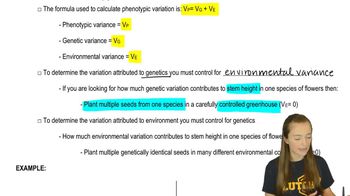Table of contents
- 1. Introduction to Genetics51m
- 2. Mendel's Laws of Inheritance3h 37m
- 3. Extensions to Mendelian Inheritance2h 41m
- 4. Genetic Mapping and Linkage2h 28m
- 5. Genetics of Bacteria and Viruses1h 21m
- 6. Chromosomal Variation1h 48m
- 7. DNA and Chromosome Structure56m
- 8. DNA Replication1h 10m
- 9. Mitosis and Meiosis1h 34m
- 10. Transcription1h 0m
- 11. Translation58m
- 12. Gene Regulation in Prokaryotes1h 19m
- 13. Gene Regulation in Eukaryotes44m
- 14. Genetic Control of Development44m
- 15. Genomes and Genomics1h 50m
- 16. Transposable Elements47m
- 17. Mutation, Repair, and Recombination1h 6m
- 18. Molecular Genetic Tools19m
- 19. Cancer Genetics29m
- 20. Quantitative Genetics1h 26m
- 21. Population Genetics50m
- 22. Evolutionary Genetics29m
20. Quantitative Genetics
Analyzing Trait Variance
Problem 5b
Textbook Question
Height in humans depends on the additive action of genes. Assume that this trait is controlled by the four loci R, S, T, and U and that environmental effects are negligible. Instead of additive versus nonadditive alleles, assume that additive and partially additive alleles exist. Additive alleles contribute two units, and partially additive alleles contribute one unit to height.
Can two individuals of moderate height produce offspring that are much taller or shorter than either parent? If so, how?
 Verified step by step guidance
Verified step by step guidance1
<span>Step 1: Understand the genetic model: The problem states that height is controlled by four loci (R, S, T, U) with additive and partially additive alleles. Additive alleles contribute 2 units to height, while partially additive alleles contribute 1 unit.</span>
<span>Step 2: Define moderate height: Determine what constitutes moderate height in terms of the number of additive and partially additive alleles. For example, if each locus can have two alleles, a moderate height individual might have a mix of additive and partially additive alleles.</span>
<span>Step 3: Calculate potential allele combinations: Consider the possible combinations of alleles from the parents. Each parent can pass on different combinations of alleles to their offspring, leading to a range of possible genotypes in the offspring.</span>
<span>Step 4: Determine the range of offspring heights: Calculate the minimum and maximum possible height contributions from the alleles that the offspring could inherit. This involves considering the extremes of inheriting all additive alleles or all partially additive alleles.</span>
<span>Step 5: Analyze the potential for variation: Compare the range of possible offspring heights to the parents' heights. If the range includes values much higher or lower than the parents' heights, then it is possible for the offspring to be much taller or shorter than the parents.</span>
Recommended similar problem, with video answer:
 Verified Solution
Verified SolutionThis video solution was recommended by our tutors as helpful for the problem above
Video duration:
1mPlay a video:
Was this helpful?
Key Concepts
Here are the essential concepts you must grasp in order to answer the question correctly.
Additive and Partially Additive Alleles
Additive alleles contribute a fixed amount to a trait, in this case, height, with each allele adding two units. Partially additive alleles contribute less, specifically one unit. The combination of these alleles from both parents can lead to a range of phenotypic expressions in offspring, allowing for variability in traits like height.
Recommended video:
Guided course

New Alleles and Migration
Polygenic Inheritance
Height is a polygenic trait, meaning it is influenced by multiple genes (loci). In this scenario, four loci (R, S, T, U) are involved, and the cumulative effect of the alleles at these loci determines the overall height of an individual. This complexity allows for a wide range of possible heights in offspring, even if both parents are of moderate height.
Recommended video:
Guided course

Organelle Inheritance
Phenotypic Variation
Phenotypic variation refers to the observable differences in traits among individuals, which can arise from genetic differences and the interaction of multiple alleles. In the context of height, two moderate-height parents can produce offspring that are significantly taller or shorter due to the various combinations of additive and partially additive alleles inherited from both parents, leading to a diverse range of heights.
Recommended video:
Guided course

Genomic Variation

 8:34m
8:34mWatch next
Master Analyzing Trait Variance with a bite sized video explanation from Kylia Goodner
Start learningRelated Videos
Related Practice


